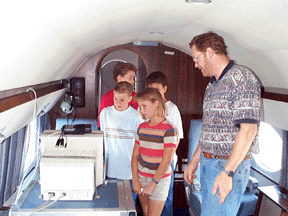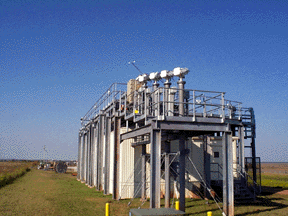
Sixth-graders from Woodlands School learn about instruments onboard a plane at ARM's site in Oklahoma/Kansas.
The Atmospheric Radiation Measurement (ARM) Program is an important part of the U.S. Department of Energy's strategy to understand global climate change. The ARM Program established three fixed research sites and a mobile facility to study a range of climate conditions. At the sites, scientists use scientific instruments and computers to gather information to study sunlight, radiant energy, and how clouds affect temperatures, weather, and climate. In addition, the ARM Mobile Facility (AMF) allows ARM researchers to study the atmosphere anywhere in the world, in any environment.
The first ARM site, located in the U.S. Southern Great Plains (SGP), began operating in 1992. Located in northern Oklahoma and Kansas, the SGP site is the largest and most extensive climate research field site in the world and can be viewed as a real "laboratory without walls." The second ARM site, in the Tropical Western Pacific, is next to the Pacific "warm pool" - off the coast of Papua New Guinea, just north of Australia. First established in 996, the TWP site has locations in Manua, Nauru, and Darwin, Australia. The third ARM site, on the North Slope of Alaska, began operating in 1998. The NSA site has locations in Barrow and Atqasuk. The ARM Mobile Facility was first deployed in 2005 in Point Reyes, California. Since then, it has also been to Niamey, Africa, and the Black Forest in Germany. The AMF consists of large shipping containers converted into laboratories. The laboratories are equipped with computer systems coonected to the high-tech instruments that collect data from the atmosphere.

ARM Radiometer Calibration Facility at the Southern Great Plains site.
Sometimes, the ARM Program conducts field campaigns at its sites or using the AMF. Some types of measurements, such as those that require research aircraft, cannot be conducted routinely because of the expense, and so field campaigns are necessary. The above picture of students in a research aircraft was taken during a field campaign.
ARM is a continuation of an effort to improve general circulation models and to provide reliable simulations of regional and long-term climate change in response to increasing greenhouse gases. The ARM Program is collaborating extensively with existing climate change programs at other agencies. For more specific information about ARM, visit the ARM website.


